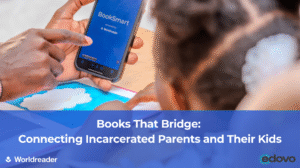Football teams often have their Hog Mollie players as a way to advance on the field. The 2nd & 7 Foundation allows children to push forward to their futures with Hog Mollies, too. When our partner 2nd & 7 began publishing in 2007, they started with their Hog Mollies book series—now available on BookSmart. What began as a term for offensive linemen soon became a collection of stories with meaningful messages for every child.
The Ohio-based foundation encourages second graders to read by providing free books to schools in low-income areas. They also pair students with athlete role models who want to make a positive impact, Executive Director Amy Hoying said. 2nd & 7 has grown to 200 programs in 26 states and has given away nearly 750,000 free books to kids since 2009.
Creating the Characters
The name “Hog Mollies” came from 2nd & 7’s founders—Mike Vrabel, Ryan Miller, and Luke Fickell. During their time on the Ohio State football team, their coach introduced them to the term he used for offensive lineman: Hog Mollies. While the three played, they enjoyed paying it forward and reading to young children. Following their graduation in 1999, Vrabel, Miller, and Fickell started their own football camp. Using the money, they bought books to read to local schools, and the 2nd & 7 “huddle” was born.
For 15 years, Hoying, along with Miller, his sister, and his business partner have created a storyline and theme for the series. The Hog Mollies collection contains 12 books in English and two in Spanish, while the last story of the series will be published in June. Hoying’s neighbor, Jason Tharp, illustrates the adventures of Duke, Sprout, Harley, and Hoppy.
“We came up with Hog Mollies because we didn’t want [the characters] to look like anybody or anything, so that [the books] could apply to every child, and every child could find messages that applied to them and not think ‘that doesn’t belong to me’,” Hoying stated.
The series has always been related to real life. Harley’s character was inspired by a football player called Chick Harley, Hoying said. Another athlete named Hopalong Cassidy influenced the character Hoppy. Co-founder Miller’s wife was in medical school at Duke University at the time, creating Duke’s name. Likewise, the themes in the books come directly from the lives of the 2nd & 7 team and their children. Teachers and librarians from schools that 2nd & 7 partners with contribute as well, Hoying stated. The lessons cover topics such as manners, sportsmanship, healthy choices, and sharing feelings.
Connecting Students and Athletes
Signing up for 2nd & 7’s program requires high school and college athletes in Ohio to sign up online by selecting Central Ohio. If an athlete in Illinois wanted to participate, they would select “Outside of Central Ohio” to be put in contact with someone who assists with programming in their state. Depending on the number of involved athletes, the player will stay with the same second grade class all year round and visit the kids 1-7 times throughout the school year, Hoying said.
Although the athletes act as role models that many students admire, 2nd & 7 follows the principle that reading and school are above sports.
“We want kids to know that it doesn’t matter how good [the athletes] are [at sports] if they’re not performing well in school, and it starts at a young age with reading and doing their homework and working hard at school,” Hoying said.
The reading sessions always begin by prefacing that reading “is the foundation for everything you want to do in your life, everywhere you want to go or anything you want to do or anything you want to be,” Hoying stated. It is made clear that if the athletes don’t do well in school, they can’t be a successful athlete. The athletes then say what the team they play for, the school they attend, and what they want to do with their lives. After sharing a favorite book they had when they were eight years old, they begin reading.
Because there are questions accompanying the passage in each book, the reading session is followed by a discussion on the book’s lessons. It’s also a time for students to ask the athlete questions, Hoying explained. At the end of the session, the book is given to the children for them to keep.
Dawn Lauridsen is the principal of the West Franklin Elementary School in Ohio, and for about 54% of the school’s population, English is the students’ second language. Franklin West has participated in 2nd & 7’s program since 2006, bringing in high school and college students to read books to the children. The books, including Hog Mollies, have shown second graders that college isn’t this unreachable “entity in the sky”—it’s attainable, she said.
“When we brought our college readers in about four weeks ago, our second graders were sharing that their animals are named after the Hog Mollies characters in the books because they’re that familiar, because every month they’re getting the Hog Mollies books and they’re taking them home,” Lauridsen said.
The Rewards of Reading with Role Models
For many kids in low-income areas, Hoying said, their world is the block that they grow up on and the school that they go to. Having role models to highlight the importance of reading creates a ripple effect of young children who wish to reach higher.
Paul Henken, an Ohio State volleyball player, has participated in the program since 2016 and is now a member of the Junior Board. He said it’s been gratifying to read to second graders and watch kids find comfort in reading in a group and work up the courage to read. In a way, it allowed children to form a “team” outside of their lives at home.
“Some unorthodox households might put these kids down just because they exist, or they might not feel represented in the classroom because of x, y, or z reasons,” Henken said. “So it’s interesting to see in that 15 minutes that they have a chance to make an impact on not only myself but for their own education.”
Hoying stated that Vrabel, Miller, and Fickell chose second grade as the foundation’s focus group because research shows that if children aren’t reading before third grade, it can be difficult to get back on track.
“We want to tell [students] you can dream big dreams, you can dream beyond where you are right now. And we want to inspire them. We want them to see reading in school as fun, not punishment,” Hoying said.
For 23 years, the 2nd & 7 Foundation has made it their mission to teach and inspire second graders. By pairing students with an athlete, they can explore both the lessons and perspectives that books offer. Because role models have set a standard for these young readers, a future of exploration and education is more possible than ever.➤ Are you a reading champion? By supporting our work, you’ll keep children in over 100 countries reading even when school is out.
➤ Are you a teacher? Partner with us and discover how to use innovative, low-cost technology and world-changing reading programs to empower your students at home and in the classroom.
➤ Are you a reader? Sign up for our newsletter to receive a world of wonder directly in your inbox.




